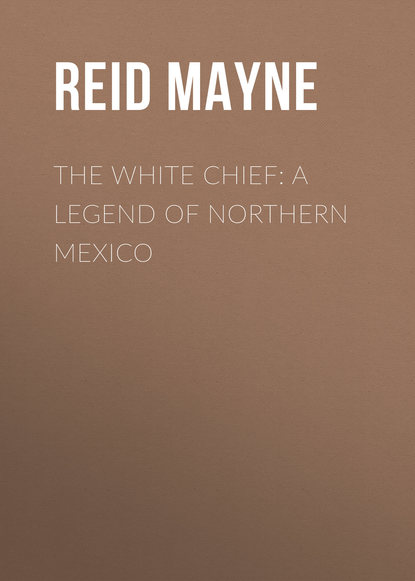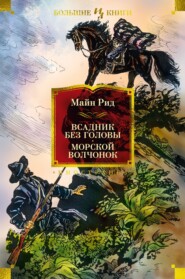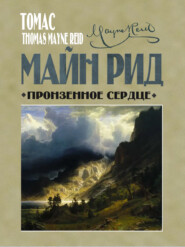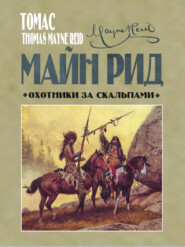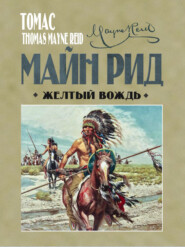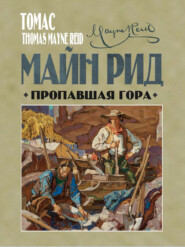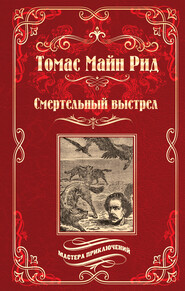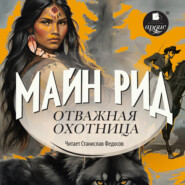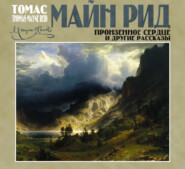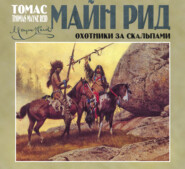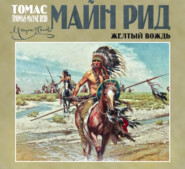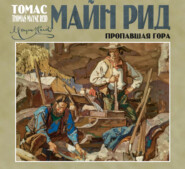По всем вопросам обращайтесь на: info@litportal.ru
(©) 2003-2025.
✖
The White Chief: A Legend of Northern Mexico
Настройки чтения
Размер шрифта
Высота строк
Поля
This play continued for a length of time, but Carlos at length grew tired of his partner, and sat down upon the banqueta alone. His eyes followed the movements of Catalina. He saw that hers were bent upon him with glances of love, – love that had been avowed in words, – yes, had already been plighted upon oath. Why should they suspect each other?
The confidence of both hearts was restored; and now the excitement of the dance, and the less zealous guardianship of Don Ambrosio, half drunk with wine, gave confidence to their eyes, and they gazed more boldly and frequently at one another.
The ring of dancers whirling round the room passed close to where Carlos sat. It was a waltz. Catalina was waltzing with the beau Echevarria. At each circle her face was towards Carlos, and then their eyes met. In these transient but oft-recurring glances the eyes of a Spanish maid will speak volumes, and Carlos was reading in those of Catalina a pleasant tale. As she came round the room for the third time, he noticed something held between her fingers, which rested over the shoulder of her partner. It was a sprig with leaves of a dark greenish hue. When passing close to him, the sprig, dexterously detached, fell upon his knees, while he could just bear, uttered in a soft whisper, the word – “Tuya!”
Carlos caught the sprig, which was a branch of “tuya,” or cedar. He well understood its significance; and after pressing it to his lips, he passed it through the button-hole of his embroidered “jaqueta.” As Catalina came round again, the glances exchanged between them were those of mutual and confiding love.
The night wore on – Don Ambrosio at length became sleepy, and carried off his daughter, escorted by Roblado.
Soon after most of the ricos and fashionables left the saloon, but some tireless votaries of Terpsichore still lingered until the rosy Aurora peeped through the “rejas” of the Casa de Cabildo.
Chapter Ten
The “Llano Estacado,” or “Staked Plain” of the hunters, is one of the most singular formations of the Great American Prairie. It is a table-land, or “steppe,” rising above the regions around it to a height of nearly one thousand feet, and of an oblong or leg-of-mutton form, trending from north to south.
It is four hundred miles in length, and at its widest part between two and three hundred. Its superficial area is about equal to the island of Ireland. Its surface aspect differs considerably from the rest of prairie-land, nor is it of uniform appearance in every part. Its northern division consists of an arid steppe, sometimes treeless, for an extent of fifty miles, and sometimes having a stunted covering of mezquite (acacia), of which there are two distinct species. This steppe is in several places rent by chasms a thousand feet in depth, and walled in on both sides by rugged impassable precipices. Vast masses of shapeless rocks lie along the beds of these great clefts, and pools of water appear at long intervals, while stunted cedars grow among the rocks, or cling from the seams of the cliffs.
Such chasms, called “cañons,” can only be crossed, or even entered, at certain points; and these passes are frequently a score of miles distant from each other.
On the upper plain the surface is often a dead level for a hundred miles, and as firm as a macadamised road. There are spots covered with a turf of grass of the varieties known as gramma, buffalo, and mezquite; and sometimes the traveller encounters a region where shallow ponds of different sizes stud the plain – a few being permanent, and surrounded by sedge. Most of these ponds are more or less brackish, some sulphurous, and others perfectly salt. After heavy rains such aqueous deposits are more numerous, and their waters sweeter; but rain seems to fall by accident over this desolate region, and after long spells of drought the greater number of these ponds disappear altogether.
Towards the southern end of the Llano Estacado the surface exhibits a very singular phenomenon – a belt of sand-hills, nearly twenty miles in breadth and full fifty in length, stretching north and south upon the plain. These hills are of pure white sand, thrown up in ridges, and sometimes in cones, to the height of a hundred feet, and without tree, bush, or shrub, to break their soft outlines, or the uniformity of their colour. But the greatest anomaly of this geological puzzle is, that water-ponds are found in their very midst – even among their highest ridges – and this water not occasional, as from rains, but lying in “lagunas,” with reeds, rushes, and nymphae growing in them, to attest that the water is permanent! The very last place where water might be expected to make a lodgment.
Such formations of drift-sand are common upon the shores of the Mexican Gulf, as well as on European coasts, and there their existence is easily explained; but here, in the very heart of a continent, it cannot be regarded as less than a singular phenomenon.
This sand-belt is passable at one or two points, but horses sink to the knees at every step, and but for the water it would be a perilous experiment to cross it.
Where is the Llano Estacado? Unroll your map of North America. You will perceive a large river called the Canadian rising in the Rocky Mountains, and running, first southerly, and then east, until it becomes part of the Arkansas. As this river bends eastwardly, it brushes the northern end of the Llano Estacado, whose bluffs sometimes approach close to its banks, and at other times are seen far off, resembling a range of mountains – for which they have been frequently mistaken by travellers.
The boundary of the west side of the “Staked Plain” is more definite. Near the head-waters of the Canadian another large river has its source. This the Pecos. Its course, you will observe, is nearly south, but your map is not correct, as for several hundred miles the Pecos runs within a few degrees of east. It afterwards takes a southerly direction, before it reaches its embouchure in the Rio Grande. Now the Pecos washes the whole western base of the Llano Estacado; and it is this very plain, elevated as it is, that turns the Pecos into its southerly course, instead of leaving it to flow eastward, like all the other prairie-streams that head in the Rocky Mountains.
The eastern boundary of the Llano Estacado is not so definitely marked, but a line of some three hundred miles from the Pecos, and cutting the head-waters of the Wichita, the Louisiana Bed, the Brazos, and Colorado, will give some idea of its outline. These rivers, and their numerous tributaries, all head in the eastern “ceja” (brow) of the Staked Plain, which is cut and channelled by their streams into tracts of the most rugged and fantastic forms.
At the south the Llano Estacado tapers to a point, declining into the mezquite plains and valleys of numerous small streams that debouch into the Lower Rio Grande.
This singular tract is without one fixed dweller; even the Indian never makes abode upon it beyond the few hours necessary to rest from his journey, and there are parts where he – inured as he is to hunger and thirst – dare not venture to cross it. So perilous is the “Jornada,” or crossing of the Llano Estacado, that throughout all its length of four hundred miles there are only two places where travellers can effect it in safety! The danger springs from the want of water, for there are spots of grass in abundance; but even on the well-known routes there are, at certain seasons, stretches of sixty and eighty miles where not a drop of water is to be procured!
In earlier times one of these routes was known as the “Spanish Trail,” from Santa Fé to San Antonio de Bexar, of Texas; and lest travellers should lose their way, several points were marked with “palos,” or stakes. Hence the name it has received.
The Llano Estacado is now rarely travelled, except by the ciboleros, or Mexican buffalo-hunters, and “Comancheros,” or Indian traders. Parties of these cross it from the settlements of New Mexico, for the purpose of hunting the buffalo, and trafficking with the Indian tribes that roam over the plains to the east. Neither the hunt nor the traffic is of any great importance, but it satisfies a singular race of men, whom chance or inclination has led to the adopting it as a means of subsistence.
These men are to the Mexican frontier pretty much what the hunter and backwoodsman are upon the borders of the Anglo-American settlements. They are, however, in many respects different from the latter – in arms and equipments, modes of hunting, and otherwise. The outfit of a cibolero, who is usually also a coureur de bois, is very simple. For hunting, he is mounted on a tolerable – sometimes a fine – horse and armed with a bow and arrows, a hunting-knife, and a long lance. Of fire-arms he knows and cares nothing – though there are exceptional cases. A lazo is an important part of his equipment. For trading, his stock of goods is very limited – often not costing him twenty dollars! A few bags of coarse bread (an article of food which the prairie Indians are fond of), a sack of “piñole,” some baubles for Indian ornament, some coarse serapés, and pieces of high-coloured woollen stuffs, woven at home: these constitute his “invoice.” Hardware goods he does not furnish to any great extent. These stand him too high in his own market, as they reach it only after long carriage and scandalous imposts. Fire-arms he has nothing to do with: such prairie Indians as use these are furnished from the eastern side; but many Spanish pieces – fusils and escopettes – have got into the hands of the Comanches through their forays upon the Mexican towns of the south.
In return for his outlay and perilous journey, the cibolero carries back dried buffalo-flesh and hides – some the produce of his own hunting, some procured by barter from the Indians.
Horses, mules, and asses, are also articles of exchange. Of these the prairie Indians possess vast herds – some individuals owning hundreds; and most of them with Mexican brands! In other words, they have been stolen from the towns of the Lower Rio Grande, to be sold to the towns of the Upper Rio Grande, and the trade is deemed perfectly legitimate, – at least, there is no help for it as the case stands.
The cibolero goes forth on the plains with a rare escort. Sometimes a large number of these men, taking their wives and families with them, travel together just like a tribe of wild Indians. Generally, however, one or two leaders, with their servants and equipage, form the expedition. They experience less molestation from the savages than ordinary travellers. The Comanches and other tribes know their object, and rather encourage them to come amongst them. Notwithstanding, they are often cheated and ill-used by these double-faced dealers. Their mode of transport is the pack-mule, and the “carreta” drawn by mules or oxen. The carreta is of itself a picture of primitive locomotion. A pair of block-wheels, cut out of a cotton-wood tree, are joined by a stout wooden axle. The wheels usually approach nearer to the oval, or square, than the circular form. A long tongue leads out from the axle-tree, and upon top of this a square, deep, box-like body is placed. To this two or more pairs of oxen are attached in the most simple manner – by lashing a cross-piece of wood to their horns which has already been made fast to the tongue. The animals have neither yoke nor harness, and the forward push of the head is the motive power by which the carreta is propelled. Once in motion, the noise of the wooden axle is such as to defy description. The cries of a whole family, with children of all sizes, in bitter agony, can alone represent the concert of terrible sounds; and we must go to South Mexico to find its horrid equal in a troop of howling monkeys.
Chapter Eleven
About a week after the fiesta of Saint John, a small party of ciboleros was seen crossing the Pecos, at the ford of the “Bosque Redondo.” The party was only five in number, and consisted of a white man, a half-blood, and three pure-bred Indians, having with them a small atajo of pack-mules, and three ox-team carretas. The crouching trot of the Indians, as well as their tilma dresses and sandalled feet, showed that they were “Indios mansos.” They were, in fact, the hired peons of Carlos the cibolero – the white man, and chief of the party.
The half-blood – Antonio by name – was “arriero” of the mule-train, while the three Indians drove the ox-teams, guiding them across the ford with their long goads. Carlos himself was mounted upon his fine black horse, and, muffled in a strong serapé, rode in front to pilot the way. His beautiful manga had been left behind, partly to save it from the rough wear of such an expedition, and also that it might not excite the cupidity of the prairie Indians, who, for such a brilliant mantle as it was, would not hesitate to take his scalp. Besides the manga, the embroidered jacket, the scarlet scarf, and velveteen calzoneros, had all been put off, and others of a coarser kind were now worn in their place.
This was an important expedition for Carlos. He carried with him the largest freight he had ever taken upon the prairies. Besides the three carretas with four oxen each, the atajo consisted of five pack-mules, all loaded with merchandise – the carretas with bread, piñole, Spanish beans, Chilé peppers; and the packs were made up of serapé blankets, coarse woollen cloth, and a few showy trinkets, as also some Spanish knives, with their pointed triangular blades. It was his bold luck on the day of the fiesta that had enabled him to provide such a stock. In addition to his own original onza and the two he had won, the young ranchero, Don Juan, had insisted upon his accepting the loan of five others towards an outfit for this expedition.
The little troop, having safely forded the Pecos, headed towards the “ceja” of the Llano Estacado, that was not far distant from the crossing of Bosque Redondo. A sloping ravine brought them to the top of the “mesa,” where a firm level road lay before them – a smooth plain without break or bush to guide them on their course.
But the cibolero needed no guide. No man knew the Staked Plain better than he; and, setting his horse’s head in a direction a little south of east, the train moved on. He was striking for one of the head branches of the Red River of Louisiana, where he had heard that for several seasons past the buffalo had appeared in great numbers. It was a new route for him – as most of his former expeditions had been made to the upper forks of the Texan rivers Brazos had Colorado. But the plains around these rivers were at this time in undisputed possession of the powerful tribe of Comanches, and their allies, the Kiawas, Lipans, and Tonkewas. Hence, these Indians, uninterrupted in their pursuit of the buffalo, had rendered the latter wild and difficult of approach, and had also thinned their numbers. On the waters of the Red River the case was different. This was hostile ground. The Wacoes, Panés, Osages, and bands from the Cherokee, Kickapoo, and other nations to the east, occasionally hunted there, and sanguinary conflicts occurred among them; so that one party or another often lost their season’s hunt by the necessity of keeping out of each other’s range; and the game was thus left undisturbed. It is a well-known fact that in a neutral or “hostile ground” the buffalo, as well as other game, are found in greatest abundance, and are there more easily approached than elsewhere.
With a knowledge of these facts, Carlos the cibolero had determined to risk an expedition to the Red River, whose head-waters have their source in the eastern “ceja” of the Llano Estacado, and not in the Rocky Mountains as laid down upon maps.
Carlos was well armed for hunting the buffalo – so was the half-blood Antonio – and two of the three peons were also experienced hunters. Their arms consisted of the bow and lance, both weapons being preferable to fire-arms for buffalo-hunting. In one of the carretas, however, might be seen a weapon of another kind – a long brown American rifle. This Carlos kept for other and higher game, and he well knew how to use it. But how came such a weapon into the hands of a Mexican cibolero? Remember Carlos was not of Mexican origin. The weapon was a family relic. It had been his father’s.
We shall not follow Carlos and his “caravan” through all the details of their weary “journeyings” across the desert plain. At one place they made a “Jornada” of seventy miles without water. But the experienced Carlos knew how to accomplish this without the loss of a single animal.
He travelled thus. Having given his cattle as much as they would drink at the last watering-place, he started in the afternoon, and travelled until near daybreak. Then a halt of two hours was made, so that the animals should graze while the dew was still on the grass. Another long march followed, continuing until noon, then a rest of three or four hours brought the cool evening, when a fresh spell of marching brought the “Jornada” to its end, far on in the following night. Such is the mode of travelling still practised on the desert steppes of Chihuahua, Sonora, and North Mexico.
After several days’ travelling the cibolero and his party descended from the high “mesa,” and, passing down its eastern slope, arrived on a tributary of the Red River. Here the scenery assumed a new aspect – the aspect of the “rolling” prairie. Gentle declivities, with soft rounded tops declining into smooth verdant vales, along which meandered streams of clear and sparkling water. Here and there along the banks stood groves of trees, such as the evergreen live-oak, the beautiful “pecan” with its oblong edible nuts, the “overcup” with its odd-looking acorns, the hackberry with its nettle-shaped leaves and sweet fruits, and the silvery cotton-wood. Along the swells could be seen large trees standing apart, and at almost equal distances, as though planted for an orchard. Their full leafy tops gave them a fine appearance, and their light pinnate leaves, with the long brown legumes hanging from their branches, told they were the famous “mezquite” trees – the American acacia. The red mulberry could be seen in the creek bottoms, and here and there the beautiful wild-china-tree with its pretty lilac flowers. The whole surface both of hill and valley was clad in a rich mantle of short buffalo grass, which gave it the aspect of a meadow lately mown, and springing into fresh verdure. It was a lovely landscape, and no wonder the wild bulls of the prairies chose it for their favourite range.
The cibolero had not travelled far through this favoured region until he came upon the buffalo sign – “roads”, “wallows”, and “bois de vache;” and next morning he found himself in the midst of vast herds, roaming about like tame cattle, and browsing at their leisure. So little shy were they, they scarce deigned to make off at his approach!
Of course he had reached the end of his journey. This was his great stock-farm. These were his own cattle – as much his as any one else’s; and he had nothing more to do but set to killing and curing.
As to his trade with the Indians, that would take place whenever he should chance to fall in with a party – which he would be certain to do in the course of the season.
Like all men of the prairie, rude trappers as well as Indians, Carlos had an eye for the picturesque, and therefore chose a beautiful spot for his camp. It was a grassy bottom, through which ran a clear “arroyo” of sweet water, shaded by pecan, mulberry, and wild-china-trees, and under the shadow of a mulberry grove his carretas were halted and his tent was pitched.
Chapter Twelve
Carlos had commenced his hunt, and was making rapid progress. In the first two days he had slaughtered no less than twenty buffaloes, and had them all carried to camp. He and Antonio followed the buffalo and shot them down, while two of the peons skinned the animals, cut up the meat, and packed it to camp. There, under the hands of the third, it underwent the further process of being “jerked,” that is, cut into thin slices and dried in the sun.
The hunt promised to be profitable. Carlos would no doubt obtain as much “tasajo” as he could carry home, besides a large supply of hides, both of which found ready sale in the towns of New Mexico.
On the third day, however, the hunters noticed a change in the behaviour of the buffalo. They had suddenly grown wild and wary. Now and then vast gangs passed them, running at full speed, as if terrified and pursued! It was not Carlos and his companion that had so frighted them. What then had set them a-running?
Carlos conjectured that some Indian tribe was in the neighbourhood engaged in hunting them.
His conjecture proved correct. On ascending a ridge which gave him a view of a beautiful valley beyond, his eye rested upon an Indian encampment.
It consisted of about fifty lodges, standing like tents along the edge of the valley, and fronting towards the stream. They were of a conical form, constructed of a framework of poles set in a circle, drawn together at their tops, and then covered with skins of the buffalo.
“Waco lodges!” said the cibolero, the moment his practised eye fell upon them.
“Master,” inquired Antonio, “how do you tell that?” Antonio’s experience fell far short of that of his master, who from childhood had spent his life on the prairies.
“How!” replied Carlos, “by the lodges themselves.”





